CSKA Moscow have been the most successful Russian club of the current century: six league titles and seven cup titles, capped by the UEFA Cup trophy in 2005. Shaped by the tactics of head coaches Valeri Gazzaev and Leonid Slutsky, they were the figurehead of Russian football and a regular guest in the Champions League.
Arguably, CSKA’s biggest strength was the consistency that allowed them to compete year after year. The squad was characterized by a core of the best Russian players refined with foreign talents, such as the Brazilians Vagner Love and Jô.
This leads us to the problem that CSKA had to face during the last three years: every career has a limited time frame and every golden era comes to an end at some point. Their core was ageing and CSKA missed the chance to rejuvenate and refresh it with young talents. The reasons for that are multilayered as we will point out in our analysis.
However, CSKA are now on the way to master this transformation. They brought in lots of young talented players from their own academy and abroad. According to CIES Football Observatory, they gave the second-most minutes to players under 21 in 31 European top divisions. In this tactical analysis, we will take a closer look at how CSKA Moscow made this transition.
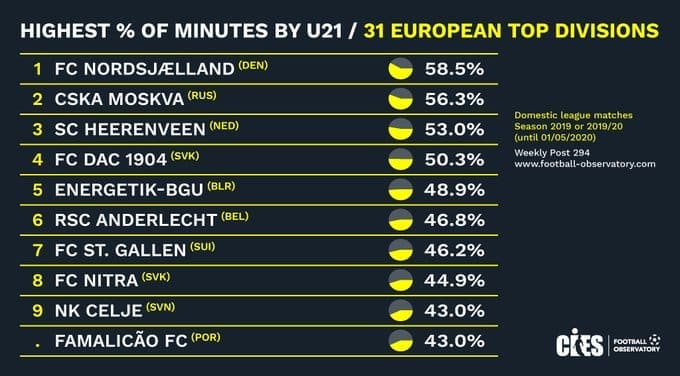
The turning point
In hindsight, the appointment of the current head coach of Viktor Goncharenko on December 12, 2016, was one of the crucial steps in CSKA’s development. After winning the title the year before, Leonid Slutsky retired from his job and the then 39-year-old took over. At that point, CSKA’s starting lineup had an average age of 28.44 and was composed to win now, not in the future.
Also, in the following season 2017/18, things did not change in the squad of the Army Men, as they are called. They promoted four youngsters from their own academy, but they saw hardly any time on the pitch and thus, the core of the starting lineup remained the same. However, it was evident that the team was getting too old, which was not sustainable in the long-term.
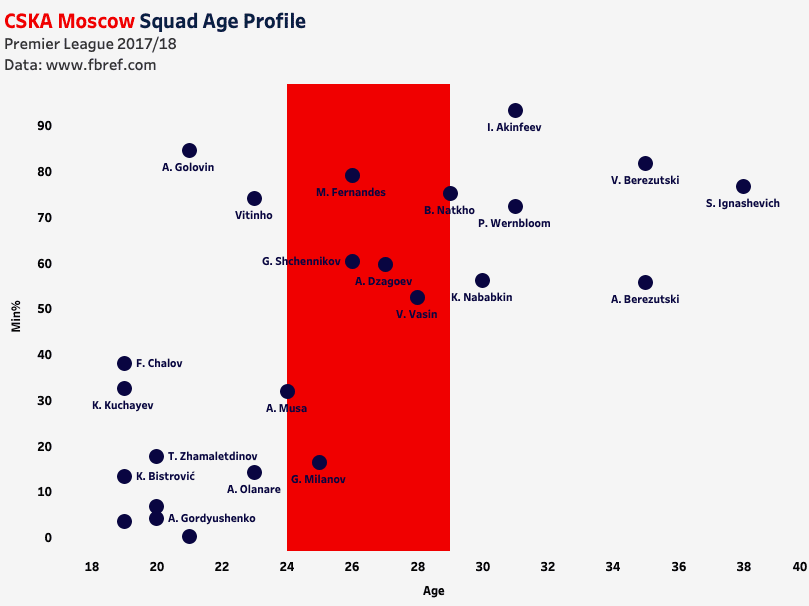
Therefore, it became radical in the following summer of 2018. After a solid season, in which CSKA finished second to Lok Moscow, seven regular starters left the club, all of whom have played more than 50% of all minutes in 17/18. Especially the career-ending of Vasili Berezutski (36-years-old), Aleksey Berezutski (36), and Sergey Ignashevich (38) deserves to be highlighted in this regard. The three centre-backs have already been part of CSKA when they won the UEFA Cup in 2005 and represented the club like no one else.
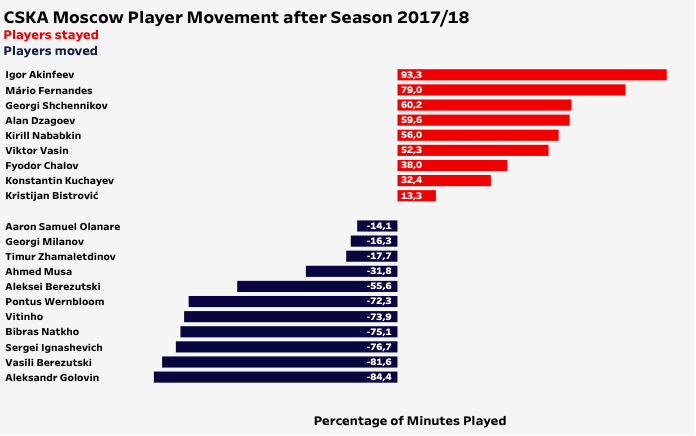
Apart from the three veterans, Pontus Wernbloom (32) and Bibras Natkho (30) also decided to not renew their contract and joined new clubs for free. Furthermore, after his convincing performances at the World Cup, Aleksandr Golovin left CSKA as well and joined French side AS Monaco for a record fee of €30 m.
While the loss of their star player hurt Goncharenko and his team, the club could use that money very well as we will further point out in the next section. All in all, the average age of 14 players that left in the summer of 2018 was 29.78, while the average age of 16 new signings/promotions was 20.56.
The beauty of financial constraints
It does sound counterintuitive at first glance. We all know that money has an influence and that we can only dream as high as our budget allows us to. However, to some extent, we also know that financial constraints can make you creative and more efficient with your resources at hand. Numerous clubs, such as Dortmund or Lille, have shown how you can deal with financial constraints and build a young roster with future potential. Also, CSKA were, and still are, not able to spend big on new players but to think differently and identify undervalued talent.
One reason for that is their owner Evgeny Giner. CSKA do not have a generous sponsor like Gazprom at Zenit or an investment-friendly billionaire-owner like Spartak or Krasnodar. Instead, Giner lost a lot of money due to the Ukrainian war, which made it impossible for CSKA to compete with their peers financially.
The sharp drop in transfer expenditure can also be linked to the construction and opening of their own stadium in 2016, which cost $350m (= €320m). While it’s certainly great and future-oriented to build a new, modern stadium it comes at the cost of not being able to spend the money on new players.
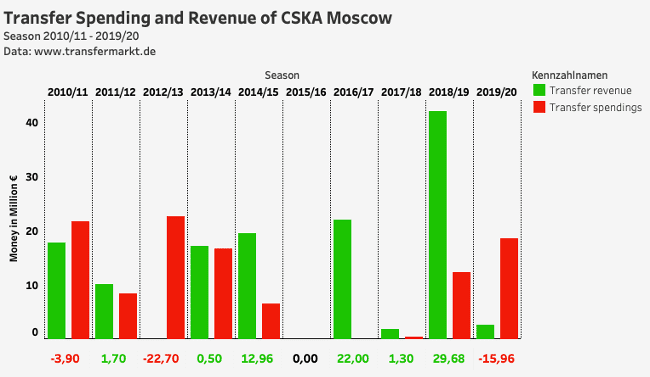
Transfer Business and the start of rebuilding
In the NBA and other American sports, you would call such a radical change a rebuild and it describes CSKA’s process very well. They came to a point where they were no longer able to compete for the championship, while the team was getting too old with previous star players being past their prime. The man responsible for the rejuvenation was Roman Babaev, who became managing director at the age of only 29 in 2007.
Since CSKA had already clarified the head coach-question with the appointment of Goncharenko, the next task of Babaev was to bring in new hungry players, who want to prove themselves. When a club tries to refresh their squad, you can mostly track that with its moves on the transfer market. What we indicated in previous sections, becomes even more salient when looking at the number of players CSKA signed in the last transfer windows.
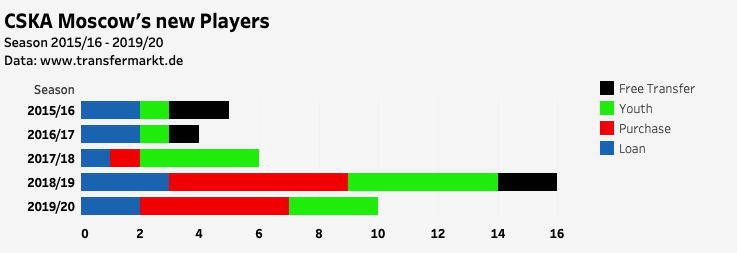
Here is what we can conclude from this chart:
- CSKA only bought one player for a transfer fee from 2015/16 till 2017/18, which shows their passiveness and their financial constraints.
- The promotion of youth players clearly increased from 2017/18 on. All in all, 12 players were promoted in the last three seasons.
- Loan deals are very welcome to reduce the risk of signing players immediately.
- The enormous number of new players in 2018/19, which we discussed earlier is also evident.
What’s not visible in the chart is the fact that they only signed four players that were older than 22 since 2017. To put that into context: in the same time, 28 players were signed or promoted, who were 22 years old or younger.
The focus on academy players is further emphasized when looking at the leagues CSKA recruited from in previous years. There’s an obvious tendency towards Russian players while English leagues (Premier League and Championship)are there most frequent targets to buy players from abroad.
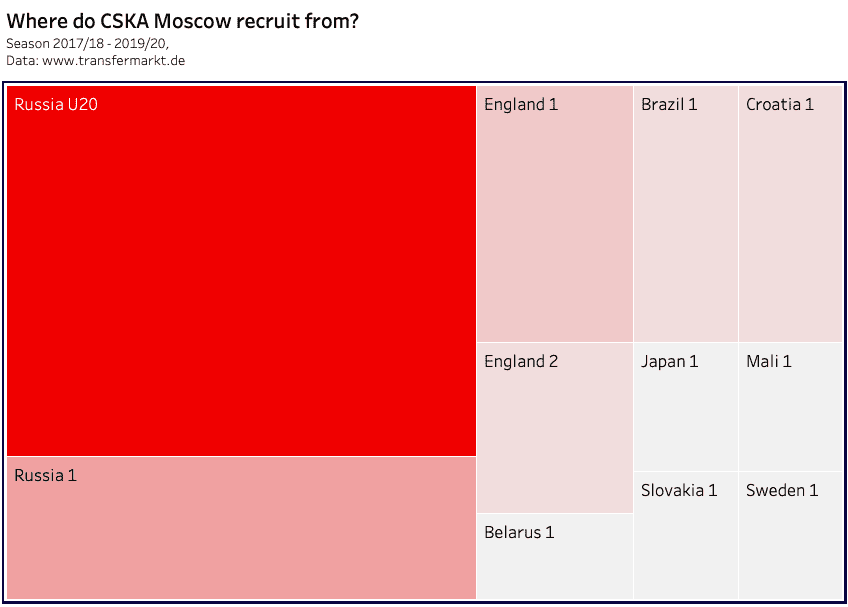
Nevertheless, it also highlights CSKA’s ability to scout “second-best leagues”, where players might be cheaper compared to the top 5 leagues. In fact, especially the signings from Sweden, Croatia, and Slovakia increased their market value significantly since their arrival in Russia.
Coming back to the chart from the beginning of this section, it also reveals CSKA’s preference for loan deals, which are a valuable alternative to expensive signings. It allows them to strengthen their squad in the short-term and to get to know the quality of the players even better. If the players perform at a high level, they try to sign them permanently as they did with Nikola Vlasic and Igor Diveev, both of whom have impressed since their arrival. The reason for that is as simple as it can be: reducing the risk of expensive mistakes on the transfer market.
How CSKA create value
It’s one thing to rejuvenate a squad on paper, but it’s another thing to sign the right players and consistently trust them. When we look at the average age of CSKA’s starting lineup in the last two years, we can quickly see the dramatic decrease, which shows us that coach Goncharenko did definitely trust his young players.
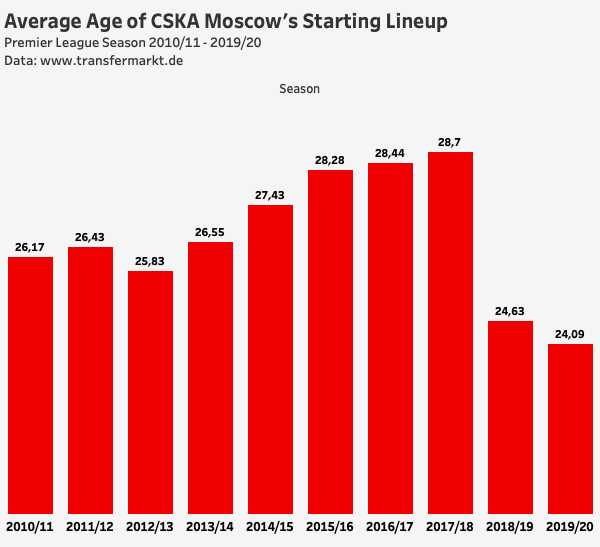
However, he hardly had an alternative given the loss of all the older players combined with the signings of youngsters. Where it becomes really interesting is when we evaluate how their new signings actually performed. While a thorough analysis of all players would exceed the scope of this analysis, we will, therefore, take the percentage of minutes played in their first season and the development of their market value.
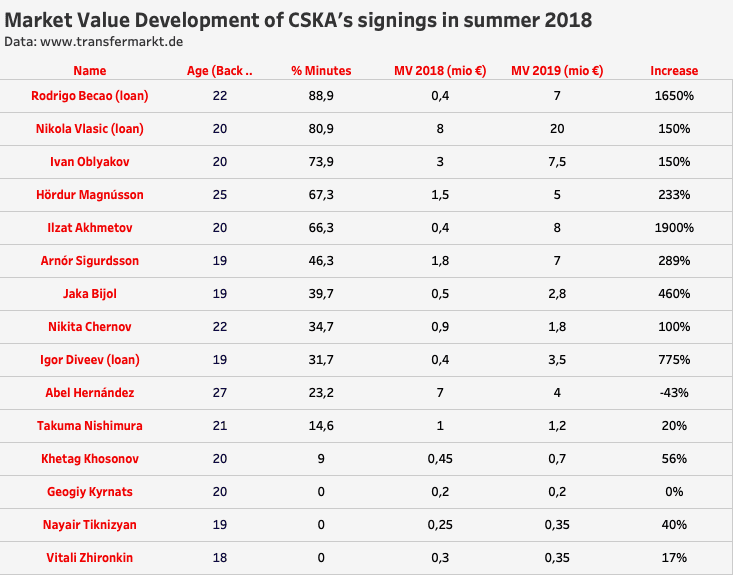
Here’s what we can conclude from this table:
- All players, except Hernández and Kyrnats, increased their market value. Nine players did that by 100% or more.
- The youth players were rather squad fillers than an integral part. Three of five did not play at all in 2018/19.
- Overall the new signings could increase their market value within one season by €43.5, which is 167% more than when they were signed.
With that said, this is by no means a final evaluation of CSKA’s signings that year, but it gives us a proper impression of what can be achieved through smart recruiting. CSKA were able to find undervalued talent at a reasonable price and develop it. This might allow them to sell them on for a profit at some point in the future. It must also be noted that the value of some players slightly decreased due to CSKA’s inconsistency in 2020 and the pandemic.
Current Squad
While we have talked a lot about the young players that Babaev & Co. brought in, we must not forget the veterans, who lead the squad and show new players the way. Next to captain and long-term servant Igor Akinfeev, Mario Fernándes is especially worth a mention. Just like Akinfeev, he did not miss a minute this season, always performing on a high level on the right-wing. In addition, he is the squad’s most valuable player at a market value of €24 m. Also, Football Manager-legend Alan Dzagoev is still present at the club; but, unfortunately, missed most parts of the season due to injury.
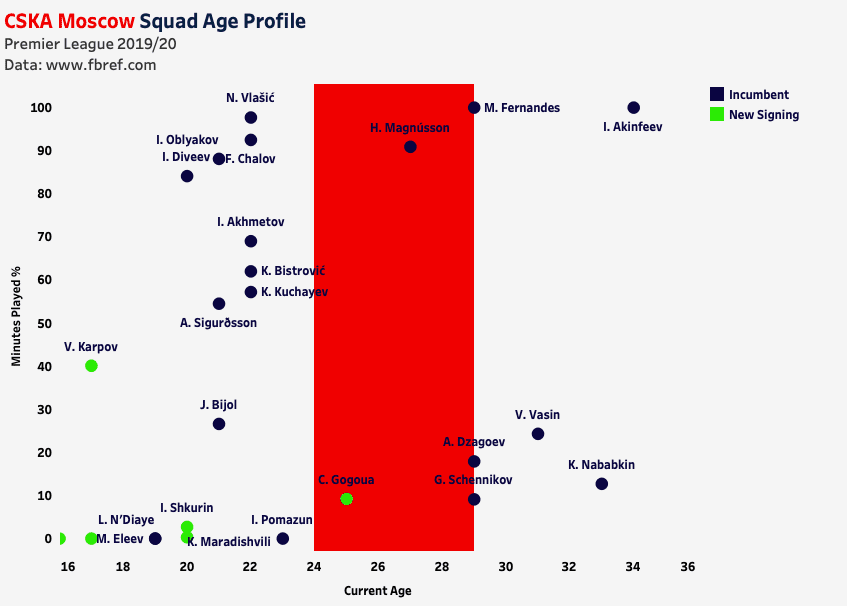
The core of the team is made up of highly talented Russians. That’s a continuation of CSKA’s DNA for many years, where the squad’s backbone consisted of the Berezutski twins or Ignashevich. This core is combined with the addition of overseas talent like record-signing Nikola Vlasic or former Bristol City player Hördur Magnússon.
While we praised the promotion of academy players throughout this article, we also have to state that only Fedor Chalov (who made the leap in 16/17) currently sees significant minutes on the pitch. Besides, 17-year-old Vladim Karpov is on the best way to so.
Overall, given the rebuild, it should not surprise that the red peak-age column is rarely occupied. However, we can see that a lot of young players get significant minutes, who are on their way to enter their peak. If CSKA can keep their core combined with valuable additions, this could be reviewed like a bright-future-squad in some years.
Another positive aspect in this regard is the fact that CSKA’s contractual situation looks decent. Currently, they do not have to fear the loss of regular starters as all of them are bound to the club until 2022 or even longer.
Future Outlook
CSKA Moscow’s current season is marked by constant inconstancy, which is not unusual for such a young squad. While they had an impressive winning streak at the beginning of the season, which led them to the top of the table, they only won two of their last eleven matches. This revealed many areas for improvement.
CSKA’s biggest need is arguably upfront as they have no alternative to Fedor Chalov, who has struggled to score consistently this season with only four goals (excluding penalties). The fact that he is still the second-best goal scorer after former Everton player Nikola Vlasic, who scored five goals (excluding penalties), is telling. Especially in matches against weaker teams, such as Ufa, it’s obvious that CSKA could need another prolific striker inside the box, who could convert one of the 26 crosses. Being in 5th position in the league as of now, CSKA won’t be able to earn significant amounts of Champions League money, but, again, try to find undervalued talent in the market.
Nevertheless, prolific goal scorers are wanted everywhere, which makes this task extremely difficult. Young prospects such as Shamar Nicholson or Vangelis Pavlidis have shown their scoring ability and might offer unique qualities that are not present in Goncharenko’s squad today.
Generally speaking, it’s going to be interesting how their rebuild will continue. As we’ve seen in this scout report, Babaev & Co. have built a strong core of young hungry players, who will certainly attract interest from European top clubs. Will they be the successors of the Berezutski-twins and Ignashevich, staying at the club for their whole career, or will they aim for a move to a bigger European club? The latter seems more likely and also in the interest of the club, which is dependent on transfer profits. Sales of their young prospects might offer CSKA even more opportunities to refine their squad in the desired way.
Conclusion
Rebuilding a squad is not for the faint of heart. It requires a stable organization and a lot of patience from all stakeholders since it’s a long-term process that can stretch over several years. However, CSKA have made important steps to become a competitor for the league title sooner rather than later again. Thanks to smart moves on the transfer market, they have some promising talents at hand, who possess a great future. Now, it’s about strengthening the squad in a targeted manner through the addition of valuable pieces that complement the existing ones.
Is it realistic that they compete for the Russian title any time soon? Perhaps. At least, they know how to win titles with a young squad: The starting lineup of CSKA that won the UEFA Cup in 2005, had an average age of 23.4 …

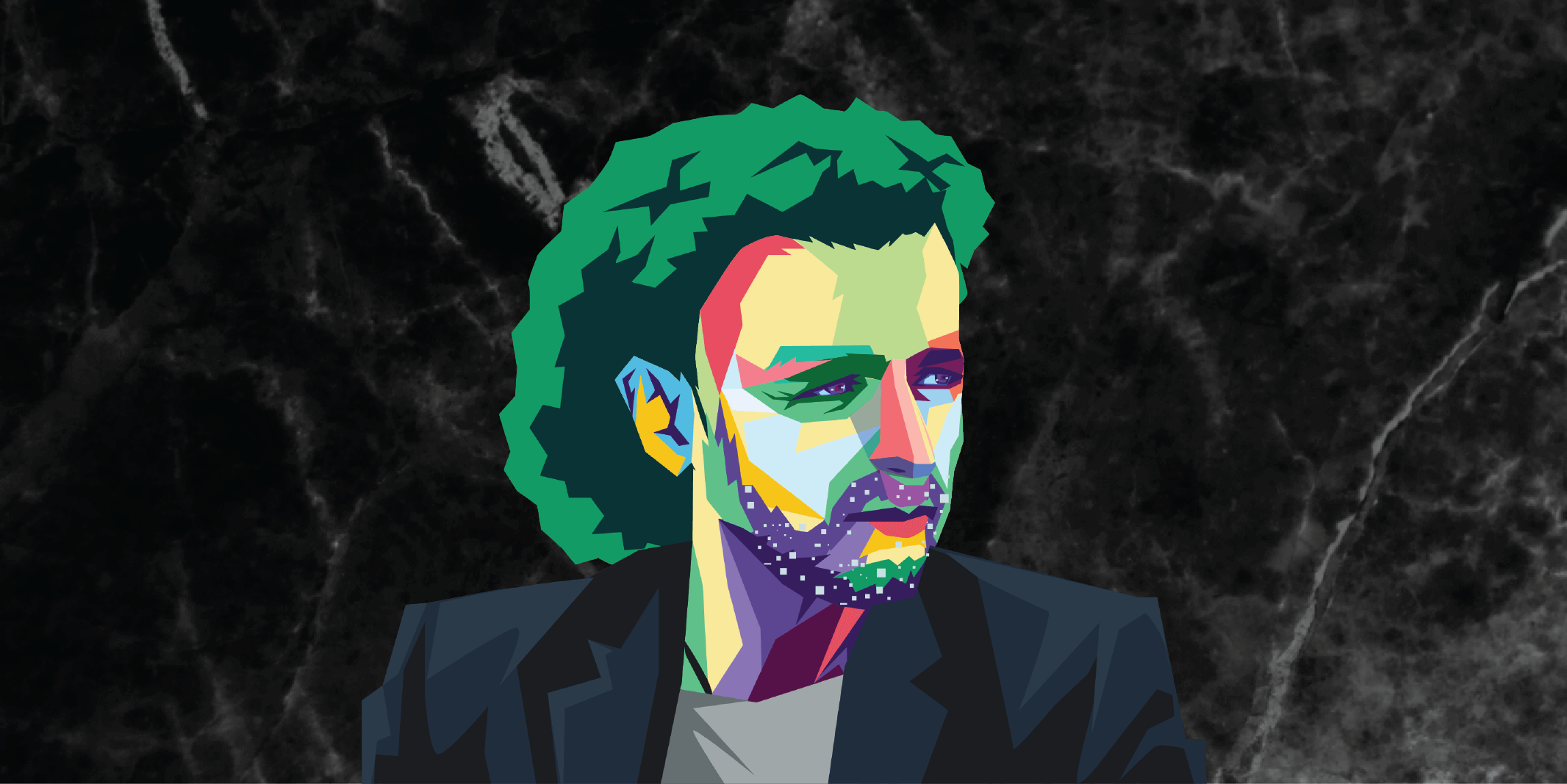



Comments